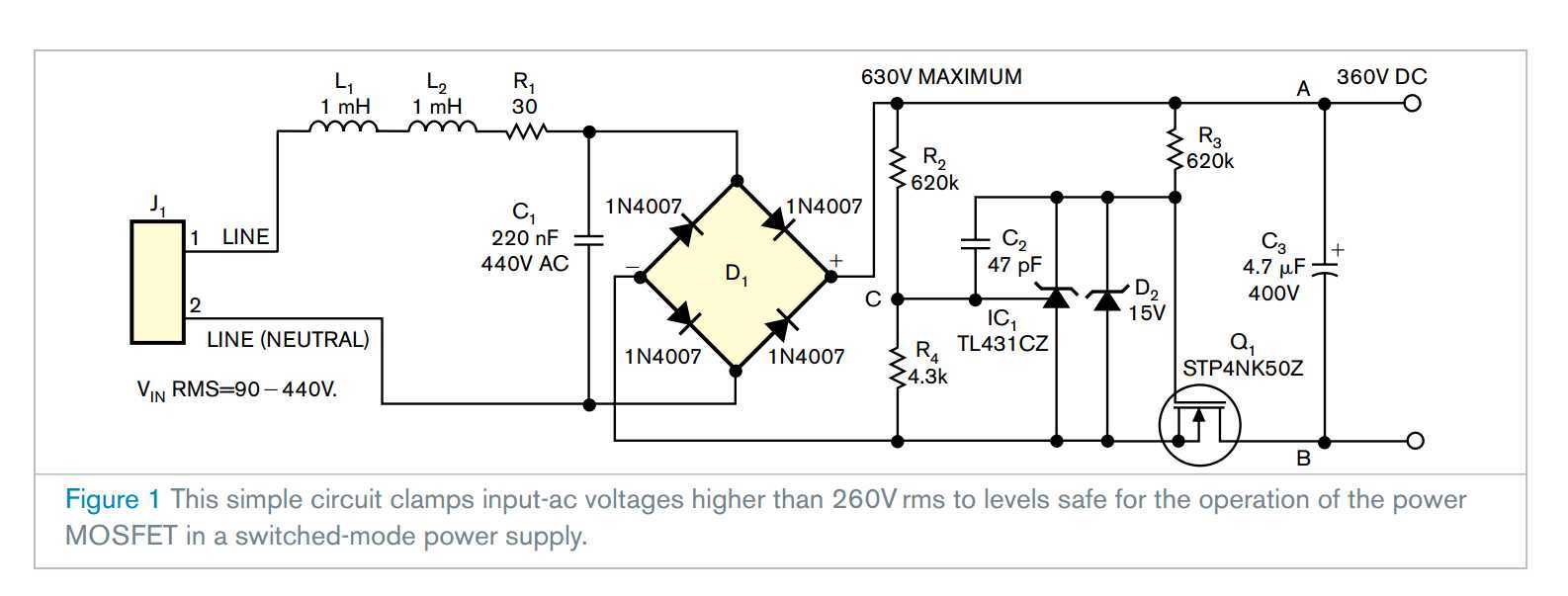标签:des blog http io ar os sp for on
Most isolated, offline SMPSs (switched-mode power supplies), including flyback, forward, and resonant, must operate at input voltages of 90 to 260V rms. Some cases even use line-to-line voltages of 400V rms±10%, leading to increased component-voltage ratings and, thus, increased cost of the overall design. In such cases, it is preferable to use input-limiting circuits, allowing you to increase the input voltage to 440V rms without damaging the power-supply components.
The circuit in Figure 1 limits, or clamps, input-ac voltages higher than 260V rms to levels safe for the operation of the power MOSFET in an SMPS. The circuit employs MOSFET Q1 working as a 100-Hz switch and shunt-regulator IC1, a TL431CZ, setting the clamped high-voltage level by divider R2 and R4. The circuit uses the component values shown. The clamped output voltage is 360V dc, the input voltage is 260V rms, and the maximum input voltage is 440V rms. The circuit was tested at power levels of 5 to 10W.
At an input voltage of less than 260V rms, Point C is less than 2.5V, and IC1 is off, sinking the minimum off-state cathode current. Zener diode D2 breaks down to 15V, ensuring a stable on-state for Q1. This operation is the normal condition of Q1 at input voltages lower than 260V rms. Accordingly, at these voltage levels, the circuit works as a standard full-bridge rectifier under capacitive load C3.
At an input voltage of 260V rms or greater, Point C becomes higher than 2.5V, and IC1turns on, diverting and sinking the current from D2. The gate-to-source voltage of Q1drops to approximately 2V, and Q1 switches off. Now, no current flows to charge bulk capacitor C3 even if the D1 bridge-rectifier diodes are forward-biased. The rectified input-ac voltage is higher than the voltage across C3, but Q1 is off, the loop is interrupted, and no current flows. Accordingly, the output-dc voltage across C3 gets limited because no charging current is available.
When the rectified ac-input voltage starts decreasing, it eventually hits the 2.5V threshold level of Point C, and Q1 again switches on. But current does not flow because the rectifier bridge’s diodes are now reverse-biased; the rectified input-ac voltage is less than the voltage across C3. The voltage across C3 decreases at a rate that the output-power level determines. Eventually, the voltage across C3 and the rectified input-ac voltage intersect at a level when the rectifier bridge’s diodes get forward-biased. Q1 is still on; therefore, charging current starts flowing. A short interval follows, during which both Q1 and D1 conduct. The short charging pulses replenish the energy loss, increasing the voltage to the limited level. When the input voltage gets higher than 260V rms, Q1 again switches off, and the whole process repeats.
Q1 has small power dissipation. During every switching period, the MOSFET is on for only 450 µsec, resulting in high efficiency for this high-voltage-limiting circuit. You can use it as a MOSFET switch with the STMicroelectronics SuperMesh MOSFET STP4NK50Z, which comes in a TO-220 package, but you can also use a Dpak to save space because the MOSFET is not a dissipative-voltage limiter. The current through Q1gets interrupted when the 50/60-Hz rectifying diodes are forward-biased. This current interruption causes ringing on the drain-to-source voltage. The clamping circuit passed the conducted EMI (electromagnetic-interference) tests, according to EN 55022 Class B, using peak and average detection. The 1-mH, 0.2A chokes, L1 and L2, suppress EMI. The 220-nF, 440V-ac capacitor, C1, is a simple snubber element across the rectifying diodes of the D1 bridge.

Use a TL431 shunt regulator to limit high ac input voltage
标签:des blog http io ar os sp for on
原文地址:http://www.cnblogs.com/shangdawei/p/4128001.html